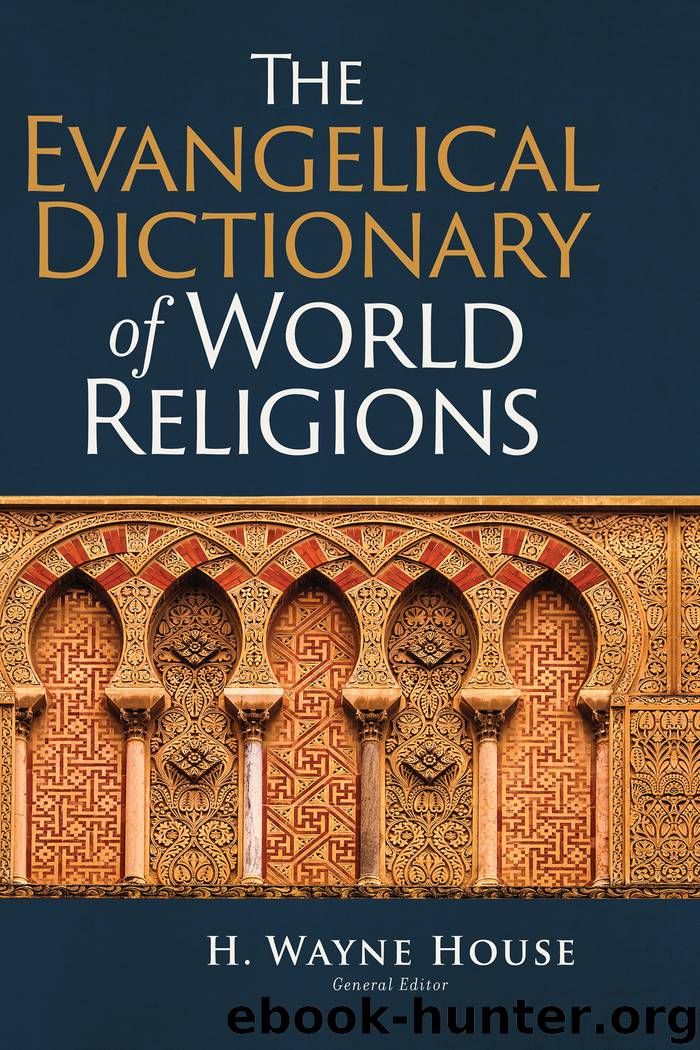The Evangelical Dictionary of World Religions by H. Wayne House

Author:H. Wayne House
Language: eng
Format: epub
Tags: Reference/World Religions, Christianity and other religions—Dictionaries, REL015000, REL033000, REL020000
ISBN: 9781493415908
Publisher: Baker Publishing Group
KOSHER (KASHER) . The basic meaning of the word kosher is something that is “fit” or “proper,” but kosher became the key rabbinic term for anything that is ritually fit, proper, or permitted. This is in contrast to terefah (or simply treif), which refers to something that is nonkosher or something that is ritually unclean or unfit.
When applied to food, kosher covers foods permitted by the Mosaic law. Therefore, beef would be kosher but pork would be terefah. However, even permitted meats can be nonkosher if they were not ritually slaughtered in the proper way. The term is also applied to nonmeat food items such as “kosher pickles.” This is often based on the way they are prepared and how they are stored. Since Mosaic law prohibits cooking a goat in its mother’s milk, dairy and meat cannot be either cooked or stored together. While many dishes can be ritually cleaned to become kosher, others must be thrown away after becoming unkosher. Due to these minute restrictions, many Orthodox Jews have two complete kitchens. Less-affluent Jews have two sets of dishes and storage containers. So ritual stipulations concerning food by rabbinic theology go beyond Mosaic law. The term kosher is also applied to items that may be proper for certain days but not for other days. Thus matzot (unleavened bread) may be kosher for all other days of the year but marked as “not kosher for Passover” if, in the preparation of the matzot, the rules necessary to make sure that no leavening could occur were not followed. Also, wine is kosher for Passover, but beer and whiskey are not, since these are made from grain or vegetables that can contain leaven.
The term kosher is also applied to the tzitzit—the tassels on the corners of Orthodox Jewish garments—if they were properly spun, and to the tefillin (phylacteries) and mezuzot (small rectangular boxes nailed to the doorways of Jewish homes), which contain scrolls that have been properly written.
See also JUDAISM
Bibliography. Rabbi B. Forst, The Laws of Kashrus: A Comprehensive Exposition of Their Underlying Concepts and Applications; Rabbi Y. Lipschutz, Kashruth: A Comprehensive Background and Reference Guide to the Principles of Kashruth; C. Roth, “Kosher,” in Encyclopedia Judaica, edited by C. Roth; I. Singer, “Kosher,” in The Jewish Encyclopedia; I. Welfeld, Why Kosher? An Anthology of Answers.
A. Fruchtenbaum
Download
This site does not store any files on its server. We only index and link to content provided by other sites. Please contact the content providers to delete copyright contents if any and email us, we'll remove relevant links or contents immediately.
| Baha'i | Cults |
| Demonology & Satanism | Eckankar |
| Egyptian Book of the Dead | Freemasonry |
| Messianic Judaism | Mysticism |
| Scientology | Theism |
| Tribal & Ethnic | Unitarian Universalism |
The Four Agreements by Don Miguel Ruiz(6638)
Breaking Free by Rachel Jeffs(4175)
The Hatha Yoga Pradipika (Translated) by Svatmarama(3234)
120 Days of Sodom by Marquis de Sade(3184)
Member of the Family by Dianne Lake(2303)
The Tao of Physics by Fritjof Capra(2231)
The Psychedelic Gospels: The Secret History of Hallucinogens in Christianity by Jerry B. Brown(2122)
The Road to Jonestown by Jeff Guinn(2021)
Going Clear: Scientology, Hollywood, and the Prison of Belief by Lawrence Wright(1940)
Going Clear by Lawrence Wright(1926)
Uriel's Machine by Christopher Knight(1866)
The Grand Grimoire: The Red Dragon by Author Unknown(1761)
The Gnostic Gospel of St. Thomas by Tau Malachi(1739)
Key to the Sacred Pattern: The Untold Story of Rennes-le-Chateau by Henry Lincoln(1596)
The Malloreon: Book 02 - King of the Murgos by David Eddings(1562)
Waco by David Thibodeau & Leon Whiteson & Aviva Layton(1531)
The New World Order Book by Nick Redfern(1527)
Animal Speak by Ted Andrews(1520)
The Secret of the Temple by John Michael Greer(1467)
